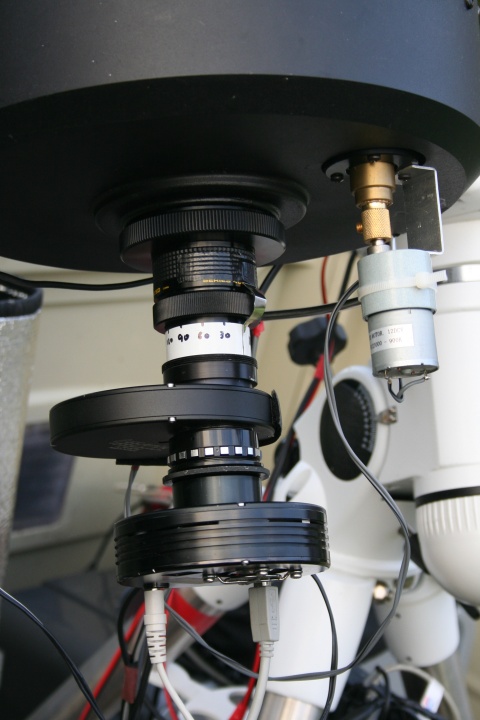Introduction Postgraduate Darryl Sergison and his supervisor Prof Tim Naylor
of Exeter University, UK have called for amateur
observations in
support
of their
observations on T
Tauri stars
planned for 2013. See AAVSO special
alert
#473 . The
targets
are moderately
faint
for
amateur
spectroscopy
(Vmag
~
10-13) so
present an
interesting target for
very low
resolution
slitless
spectroscopy
using the Star
Analyser.
This gives
the
possibility of doing
"differential
spectroscopy" using a
comparison
star in the
same
field, as
is done for
differential
photometry.
The advantage is that
precise
compensation can
be
made for
short
term variations
in
atmospheric
extinction,
allowing variations in
the spectrum total flux and
continuum
shape to
be
followed. Equipment
Celestron C11 (f10 280mm aperture) Focal reducer giving f5.1 Spacer with angle scale allowing repeatable orientation of the
setup
to avoid interfering
background stars and
spectra Filter wheel with Star Analyser (and photometric filters)
Spacer to give ~17A/pixel dispersion ATIK 16 IC-S camera EQ6 Pro / EQMOD mount unguided (~80% of 20 sec
exposures with acceptably low
trailing)

Data reduction
This setup produces around 100 x 20 sec exposures per hour. Typically a magnitude 12 star needs around 30 x 20 sec exposures to give an acceptable SNR ( > 100, reducing at the edges of the wavelength range where instrument sensitivity drops)
ISIS software is used for data reduction as it allows batch processing and a reasonable degree of automation, important when handling such large numbers of spectra. It also produces the combined and individual spectra as fits files with the correct header details and the flux either in raw counts or scaled relative to the level at a given wavelength.
The data reduction steps for the standard star (an A spectral type, used for wavelength calibration, instrument response and approximate atmospheric extinction correction), target and comparison stars (in the same field for precise extinction correction) are:-
Darks
Alignment of individual exposures using a zero order image in the field as a reference
Tilt correction
Background removal and binning (Careful selection of the background and binning zones, made independently for the target and comparison stars in the same field, is critical for good results on such faint targets. Click here for an example of selected binning and background zones using ISIS software)
Wavelength calibration (linear using zero order and H beta as measured in the standard star)
Instrument response and atmospheric extinction correction (measured at the start and end of the observing run using a nearby agreed campaign standard reference star to allow comparison between observers and refined based on simultaneous measurements of the target and comparison stars in the same field
Summing of individual spectra in groups to give adequate SNR.
Results
2012-12-09 Example of a remarkable large and fast transient in the spectrum of DN Tau
Links to spectra from other campaign contributors
http://www.spectro-aras.com/forum/viewforum.php?f=28
http://www.astrosurf.com/aras/Aras_TTauri/T_Tauri_Campaign.html
http://www.astrosurf.com/buil/campaign/ttauri/obs.htm